How to trade the MOEX (Moscow Exchange) index? [Guide]
Although Russia is one of the largest economies in Europe, investing in this capital market has a hint of "exotic" for many investors. Cutting off from this market may deprive the investor of an opportunity for above-average profits. It was especially visible in 2015, when due to the tension between the "West-Russia" line and the decline oil prices the valuations of many Russian companies have been very attractive. This article will describe the structure of the Russian stock exchange and the MOEX index.
Before the First World War, the Russian capital market was one of the most important in the world. The huge internal market, combined with rapid modernization, made Russia a promising market just before the First World War. The exhaustive war combined with the fratricidal fights between the "whites" and the "reds" during the civil war in Russia contributed to economic ruin. After 1920, communism developed in Russia, which also stopped the development of the capital market. Changes came only in 1989, when the Soviet Union and then the Russian Federation opened up more to foreign capital. The beginning of Russia's economic transformation caused a sharp increase in the places of trade (around 1700). After 1998 (the Russian crisis), the fragmented market was consolidated. In the end, there are only two players that count: RTS i MICEX. The current Moscow Stock Exchange was established in 2011 as a result of the merger of two exchanges: MICEX and RTS.

Moscow International Business Center. Source: wikipedia.org
History of the Moscow Exchange: MICEX and RTS
In 1989 it was established MICEX (Moscow Interbank Currency Exchange). Back then, MICEX was still operating under the name "Foreign trade and investment bank of the USSR". The exchange of rubles for dollars has started in this market. In 1992, stock trading began on the MICEX stock exchange. The Central Bank of Russia used MICEX for official ruble quotes. The stock exchange has become the main place for trading in stocks and bonds valued in Russian rubles.
Buy/Sell Ads RTS (Russian Trading System) was established in 1995 as an amalgamation of fragmented securities trading venues. RTS modeled itself at that time on the American NASDAQ. Already in 1998, the stock exchange created its own system for placing orders online. It is on this stock exchange that the RTS Index was created, which is the most famous benchmark for the Russian stock market. In 2001, FORTS was launched, i.e. a place for trading futures and options. In 2011, as a result of the merger of RTS and MOEX, the Moscow Stock Exchange (Московская биржа) was established.
Moscow gstock exchange
Although the current stock exchange was established in 2011, the tradition of trading in commodities and financial instruments dates back to 1839. At that time, there was a stock exchange in Moscow that organized trading in government securities. From the 70s, there was also a market for shares and bonds of private companies. However, the Moscow Stock Exchange throughout the nineteenth century was less important than other important financial centers of the Russian Empire (Saint Petersburg, Warsaw, Odessa).
After the merger of RTS and MICEX, the Moscow Stock Exchange became the largest organized trading market in Russia. In 2013, the Moscow Exchange IPO took place. Demand exceeded the number of shares offered twice. The debut was attended not only by domestic individual and institutional investors, but also by foreign capital. The stock exchange currently concentrates most of the organized trading in financial instruments in Russia. The most important indices are RTS and MOEX. In the present article, the second one will be introduced.
Chart - MOEX
What is the MOEX index
MOEX stands for The Moscow Exchange Index. It is a price index (such as Dow Jones Industrial Average), which is weighted by capitalization. The index includes the largest and most liquid companies listed on the Moscow Stock Exchange. The composition and weights in the index are changed once a quarter. Prior to 2017, the name of the index was MICEX, which dates back to 1997.
The MOEX index is responsible for approximately 90% of the capitalization of all companies listed on the Moscow Stock Exchange.
The average capitalization of a company included in the index is 1 billion rubles. However, the differences between the company with the largest and the smallest capitalization are huge. At the end of Q178 2021, the largest component of the index was valued at 6 billion rubles. In turn, the median capitalization in this period was approximately 288 billion rubles.
Index composition
According to data provided by the Moscow Exchange, the MOEX index had 2021 components at the end of the first quarter of 44. It is worth noting that this is a "book" representative of emerging markets. This is due to the composition of the index, which is dominated by raw material companies and companies from the financial industry.
The largest shares are held by companies from the following industries:
- Energy (oil and gas) - 40,20%,
- finance - 20,70%,
- metallurgical and mining industry - 18,5%,
- IT - 9,90%,
- Consumer goods - 4,00%.
The largest components of the index are the following companies:
- Sberbank,
- Gazprom,
- Lukoil,
- yandex,
- Norilsk Nickel.
Below is a brief overview of several companies included in the MOEX index.
Gazprom
It is one of the most famous Russian companies. Gazprom was founded in 1989. The company is vertically integrated. It has its own mining, transport, distribution and warehouse segments. In 2018, Gazprom was responsible for 12 percent of the world's natural gas production. The company sends its products through gas pipelines. The most famous of them are: Nord Stream, TurkStream, Soyuz, Strength of Siberia and the Yamal gas pipeline. The gas pipeline network managed by Gazprom is 177 km. Gazprom also has 000 compressor stations.
The company also has an oil production segment (Gazprom Neft). Gazprom is a state-owned company because the Russian State Treasury (Росимущество) is the majority shareholder. Gazprom sells its products to 25 European countries, to China and some countries of the Commonwealth of Independent States. Gazprom has a particularly strong position on the European market, where it controls over 32% of the market.
| billion RUB | 2017 | 2018 | 2019 | 2020 |
| revenues | 6 546,1 | 8 224,2 | 7 659,6 | 6 321,6 |
| operational profit | 854,1 | 2 038,5 | 1 365,0 | 562,6 |
| operating margin | 13,05% | 24,79% | 17,82% | 8,90% |
| net profit | 714,3 | 1 456,3 | 1 202,9 | 133,8 |
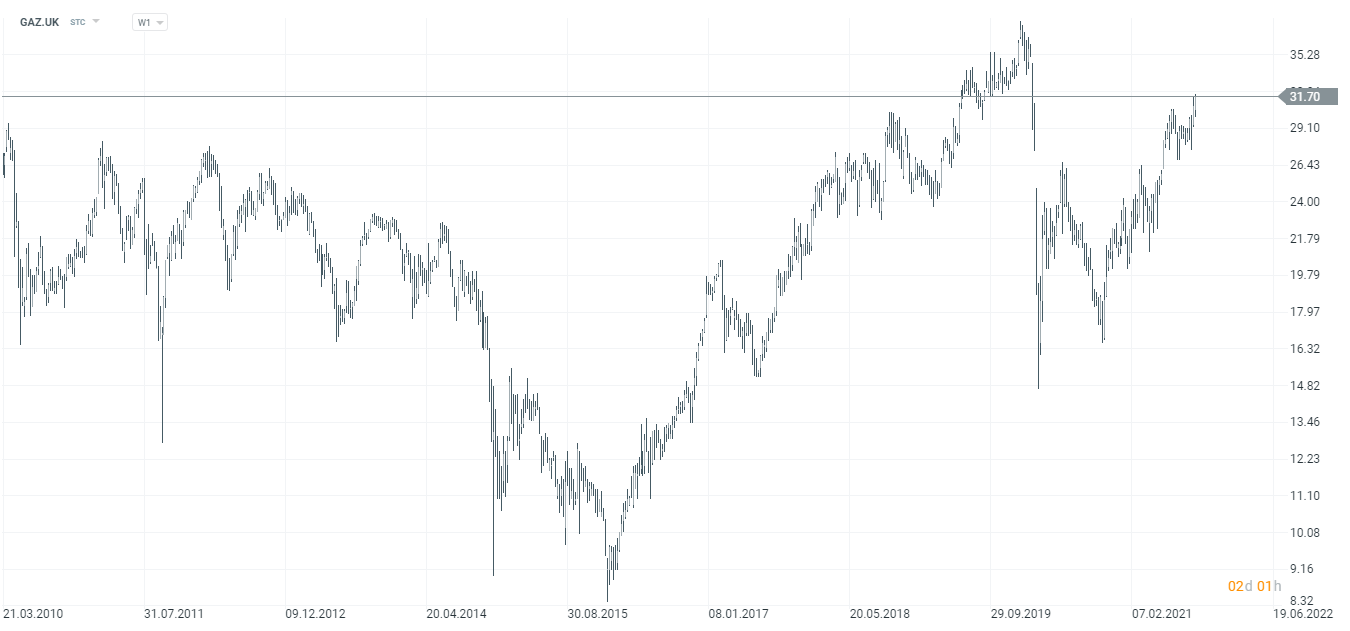
Gazprom stock chart, interval W1. Source: xNUMX XTB.
Sberbank
Although the history of state-owned savings banks in Russia dates back to the 40s, the formation of Sberbank dates back to 1991. After the collapse of the USSR, Sberbank became the largest commercial bank in Russia. Since 2007, the president of the company has been a close friend of Vladimir Putin - Herman Gref. It is the largest bank by assets in the EEMEA region (Eastern Europe, Middle East, Africa). In mid-2021, the company held 45,4% of the market share of retail deposits in Russia. The company tries to follow new technologies. In 2021, the monthly number of unique users using the bank's mobile application is approximately 69 million. About 50 million customers will benefit from loyalty programs (Spasibo). Sberbank also offers a subscription offer (Sber Prime +) offering discounts on online shopping, food delivery (Delivery Club). Sberbank also has its own online grocery delivery service (Sbermarket). It is worth mentioning that Sberbank has over 14 branches in Russia. In addition to Russia, the bank also operates in 000 countries around the world.
| Billion RUB | 2017 | 2018 | 2019 | 2020 |
| revenues | 2 267 | 2 292 | 2 305 | 2 498 |
| net profit | 750,4 | 821,2 | 844,9 | 761,1 |
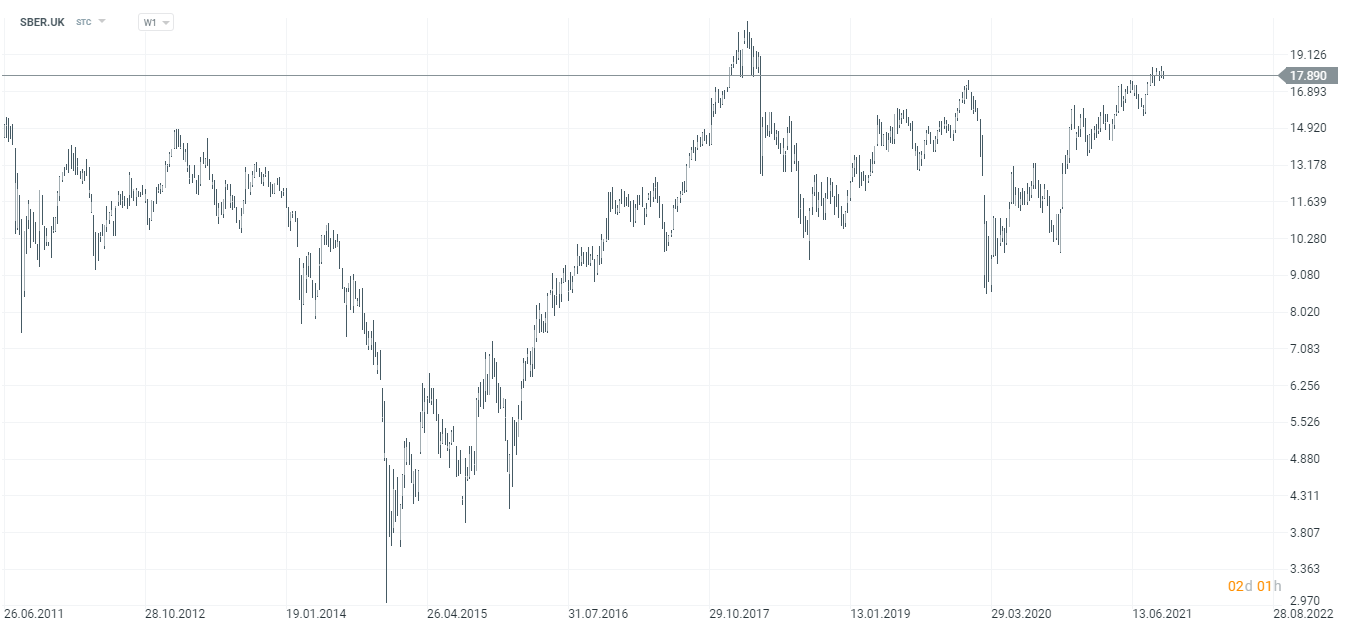
Sberbank stock chart, interval W1. Source: xNUMX XTB.
Yandex
It is one of the most famous Russian technology companies. The company is recognized mainly due to its search engine - Yandex. It is the most popular search engine in Russia. The company was established in 1997. One of the co-founders was Arkady Voloz, who still helps in the company's development. Over the past few years, the company has significantly diversified its activities. Yandex has a Mobility segment: transporting people - Yandex.taxi and car rental (Yandex.Drive). The company is also known for its Food Tech segment (Yadex.Eats)where the company offers food delivery. The company's offer also includes Yandex.Lavkawhich offers grocery delivery within 15 minutes. The company also intends to develop the segment of video streaming and online shopping (Beru). Yandex also has a subscription offer (Yandex.Plus).
| Million RUB | 2017 | 2018 | 2019 | 2020 |
| revenues | 94 054 | 127 657 | 175 391 | 218 344 |
| operational profit | 13 036 | 20 861 | 25 462 | 16 249 |
| operating margin | 13,86% | 16,34% | 14,52% | 7,44% |
| net profit | 8 776 | 47 587 | 12 826 | 25 512 |
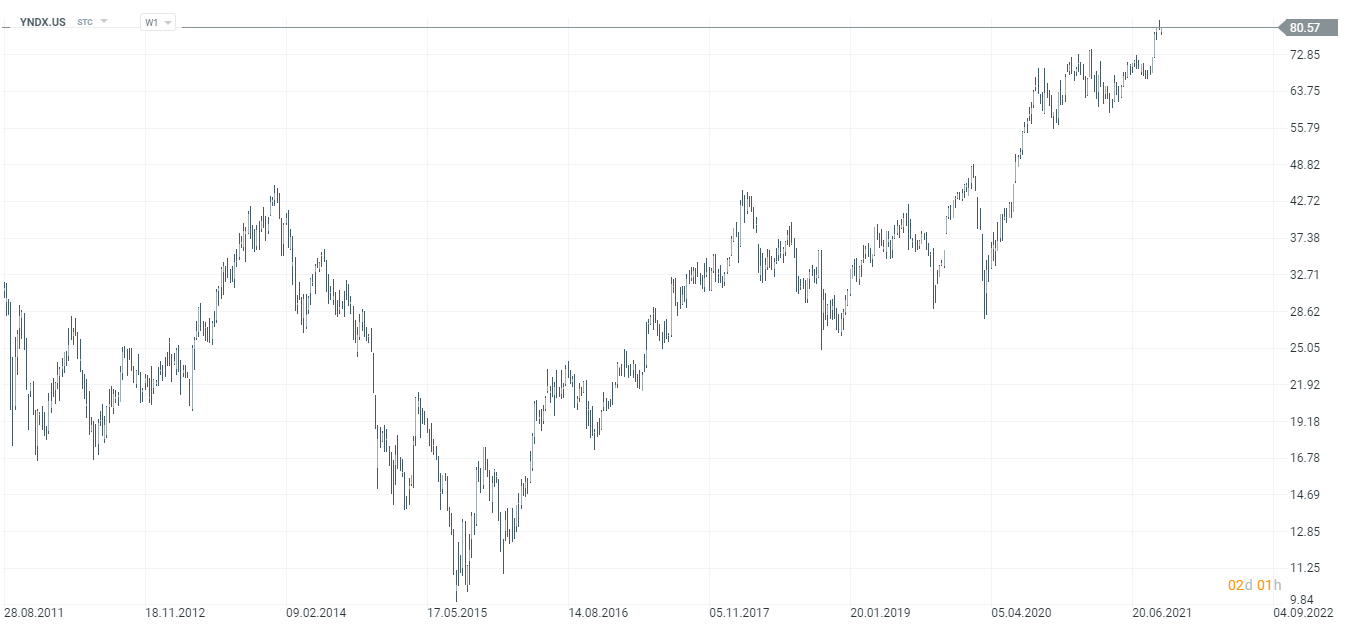
Yandex stock chart, interval W1. Source: xNUMX XTB.
Mail.ru
It is another Russian technology company. The origins of Mail.ru date back to 1998 when it entered an e-mail offer. In 2010, the company announced plans to debut on the London Stock Exchange. It has the largest social platform in Russia - VKontakte. They also have offers from Oddnoklassniki (the Russian variant of "Our Class") or Moi Mir. Thanks to its social media platforms, the company has a strong base of potential customers to monetize. Mail.ru has a passenger transport service (CitiMobil). At the same time, the company also offers food delivery via the platform DeliveryClub. Mail.ru works closely with Alibaba (in the e-commerce segment). As a result of this cooperation, Mail.ru owns a 15% stake in Aliexpress Russia Joint Venture. It should be mentioned that in the shareholding of Mail.ru you can also find companies such as Prosus (25%) and Tencent (4,8%).
| Million RUB | 2017 | 2018 | 2019 | 2020 |
| revenues | 51 744 | 66 105 | 96 231 | 100 542 |
| operational profit | 4 069 | -6 141 | 15 424 | 4 141 |
| operating margin | 7,86% | -9,29% | 16,03% | 4,12% |
| net profit | 2 261 | -7 991 | 18 686 | -20 921 |
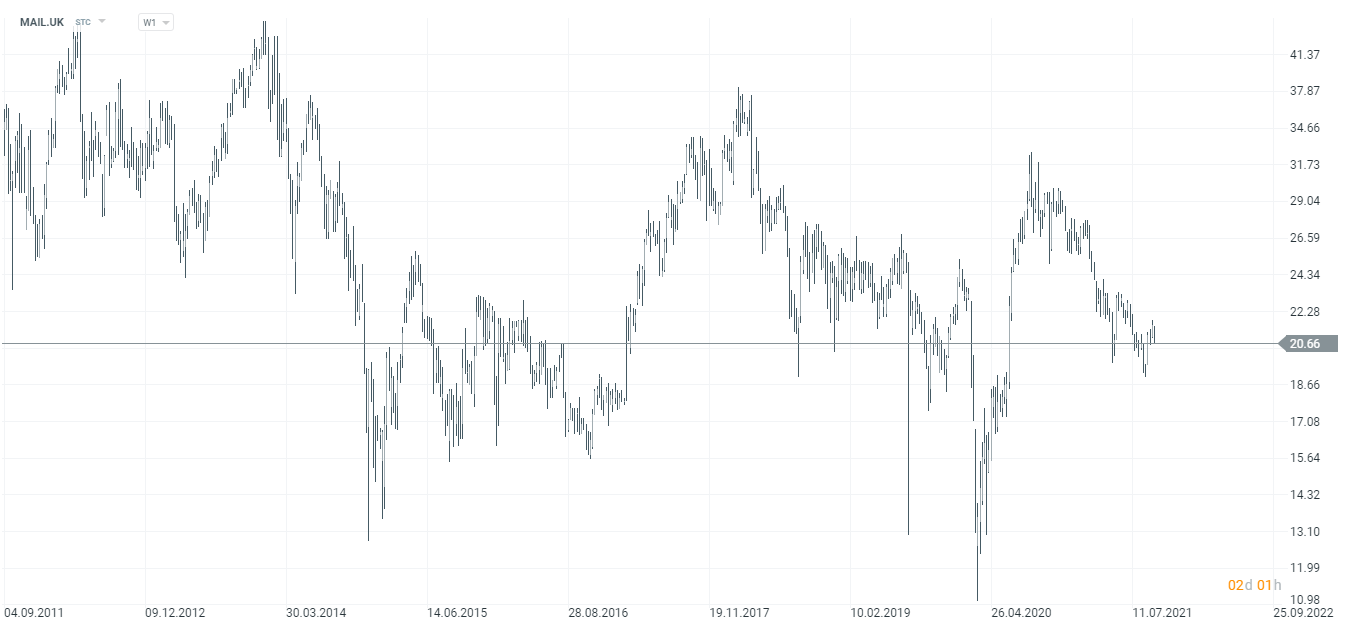
Mail.rulmart stock chart, interval W1. Source: xNUMX XTB.
Ozone
Ozon Plc is a company focusing on operating in one of the most promising markets in the world - the Russian e-commerce segment. Due to logistics problems, a large number of cash payments and the reluctance of the older generation to buy online, the share of e-commerce in retail sales is much lower than in the US, EU or China. Currently, e-commerce only accounts for 9% of retail sales. For comparison, in Great Britain the rate is already 24%, and in Poland it is 14%. Ozone invests money in the development of logistics and fulfillment. This is to improve the quality of services provided by Ozone and ensure an advantage over platforms operating according to the asset-light strategy. In addition to having its own online sales platform, Ozone has a Darkstores offer (15-minute grocery delivery). The company is developing this business concept in Moscow and Saint Petersburg.
| $ million | 2018 | 2019 | 2020 |
| revenues | 37 220 | 60 104 | 104 350 |
| operational profit | -5 874 | -18 621 | -17 323 |
| operating margin | -15,78% | -30,98% | -16,60% |
| net profit | -5 632 | -19 348 | -22 323 |
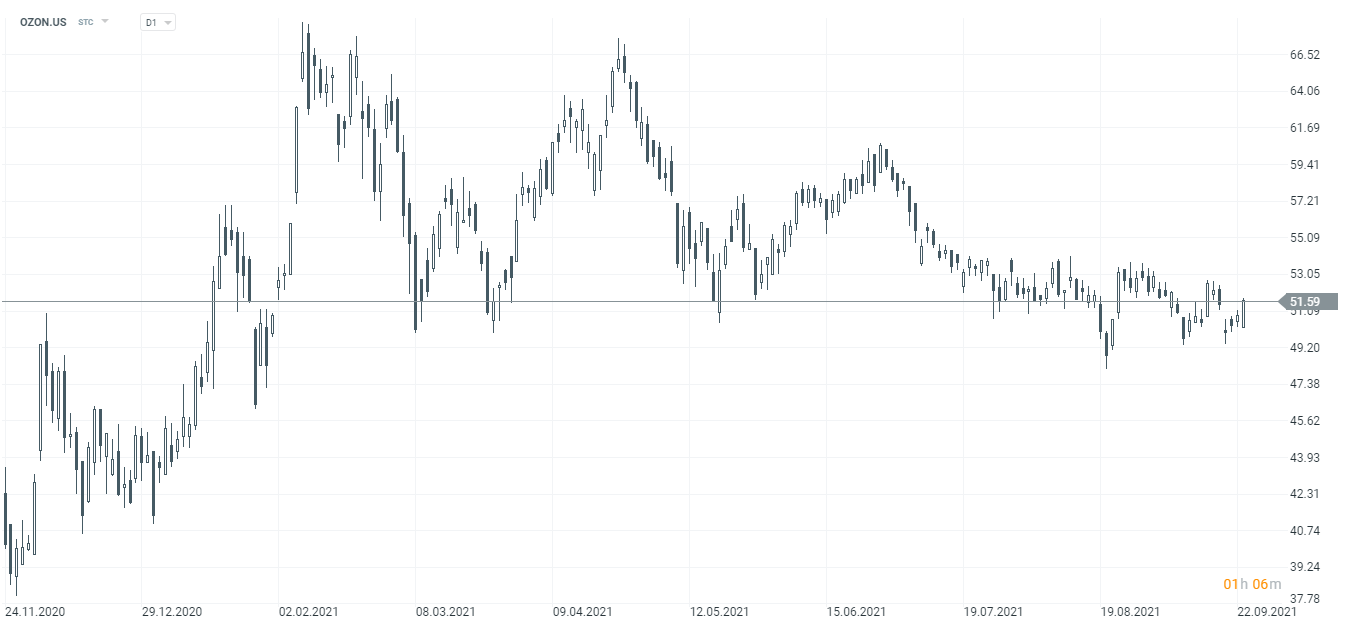
Ozon stock chart, interval W1. Source: xNUMX XTB.
Moscow Exchange
It is an exchange that was created as a result of the merger of the MICEX and RTS exchanges. In 2013, the company debuted on the stock exchange. In 2015, trading with grain futures was introduced to the offer. From 2019, MOEX announced a new dividend policy, in which it undertakes to pay at least 60% of net profit in the form of dividends. The Moscow Stock Exchange allows you to trade in stocks, bonds, futures, options. The investor can also trade currencies or commodities. MOEX is the 2nd largest bond exchange in the world by turnover. It is also in 9th place in the world in terms of the number of contracts concluded on derivatives. However, in terms of the value of trading on the stock market, the MOEX stock exchange is only in the third ten.
| Million RUB | 2017 | 2018 | 2019 | 2020 |
| revenues | 38 539 | 39 901 | 43 011 | 48 591 |
| net profit | 20 266 | 19 717 | 20 189 | 25 158 |
HeadHunter Plc
It is Russia's largest job portal. It is also a leader in its segment in countries such as Belarus, Kazakhstan and Uzbekistan. According to SimilarWeb, in April 2021 it was the 4th website of this type in the world in terms of generated traffic on the site (after Indeed, Jooble and Glassdor). HeadHunter also boasts that due to its recognition, about 80% of website traffic is obtained for free. As a result, Customer Acquisition Cost (CAC) is relatively low. The company tries to be a consolidator in the market. It took over 4 players on the Russian market, Zarplata.ru (the company focused on the Ural and Siberian regions). Due to its business model, the company incurs low capital expenditure and generates a high operating margin.
| Million RUB | 2017 | 2018 | 2019 | 2020 |
| revenues | 4 734 | 6 118 | 7 788 | 8 282 |
| Operational profit | 1 385 | 2 099 | 2 805 | 2 840 |
| Operating margin | 29,26% | 34,31% | 36,02% | 34,29% |
| net profit | 402 | 949 | 1 448 | 1 749 |
What can affect the value of the MOEX index?
The condition of the Russian economy
Many of the companies that are components of the MOEX index generate most of their revenues in Russia. For this reason, the condition of this economy translates into the development of this type of companies. For example, the economic downturn in Russia may affect the quality of the loan portfolio of the largest Russian bank - Sberbank.
The situation in individual industries
The decline in retail sales may affect the results of Magnit (supermarket chain), x5 retail (supermarkets) and Dietsky Mir (chain of stores for children). On the other hand, positive or negative changes in the banking industry may affect the results of Russian banks that are part of the MOEX index (Sberbank, TCS Bank, VTB). Another example is the collapse of the aviation industry in response to the COVID-19 pandemic. This worsened Aeroflot's performance.
Raw material prices
Sometimes the prices of raw materials have an impact on the volume of sales and profits of raw material companies. MOEX has a very large exposure to companies of this type. An example is Gazprom, whose long-term prospects depend on prices natural gas. Another example would be Polyus, which is the manufacturer gold.
Financial results of companies
In the long term, the financial results generated by the enterprise are the most important in the valuation of the company. Increasing revenues, profits, and free cash flow (FCF) are solid arguments for long-term increases in stock prices. For this reason, it is worth following the financial results of companies included in the index. Especially those that have the greatest impact on changing the index value.
How You Can Invest in the MOEX
MOEX Futures
On the Moscow Stock Exchange it is possible to trade futures on the MOEX index. The value of one point is 100 rubles. As a result, the current face value of the futures contract is over 400 rubles. It is also possible to trade mini futures, which correspond to 000/1 of the value of a "normal" contract.
Contracts for exchange differences (CFDs)
Although contracts for difference (CFDs) are an extremely popular instrument, CFDs based on Russian stock indices are a real rarity that few can offer. Among the popular European brokers, only XTB offers a derivative based on the Russian RTSI index - #RUS50 - which reflects the situation in the 50 largest companies from Russia, including the above-mentioned. The leverage on this CFD is 1:10.
| Broker |  |
| End | Poland |
| RTSI symbol | RUS50 |
| Min. Deposit | PLN 0 (recommended min. PLN 2000 or USD 500, EUR) |
| Min. Lot value | price * 100 USD |
| Commission | - |
| Platform | xStation |
CFDs are complex instruments and come with a high risk of losing money rapidly due to leverage. From 72% to 89% of retail investor accounts record monetary losses as a result of trading CFDs. Think about whether you understand how CFDs work and whether you can afford the high risk of losing your money.
ETF on MOEX, stock purchase
One of the easiest ways to gain exposure to the Russian stock market is to buy ETF. An example is the iShares MSCI Russia ETF, which has 25 of the largest and most liquid Russian companies in its portfolio. The three largest components of this ETF (Gazprom, Sberbank, Lukoil) have a total share of 3% in the ETF. It is worth mentioning that the annual management cost (TER) is 45%. Assets under iShares Russia's management amount to just over $ 0,59 million. Another option is to buy shares in companies from the Russian index.
Brokers offering stocks and ETFs
For example on XTB Today, we can find over 3500 equity instruments and 400 ETFs, a Saxo Bank over 19 companies and 000 ETF funds.
| Broker |  |
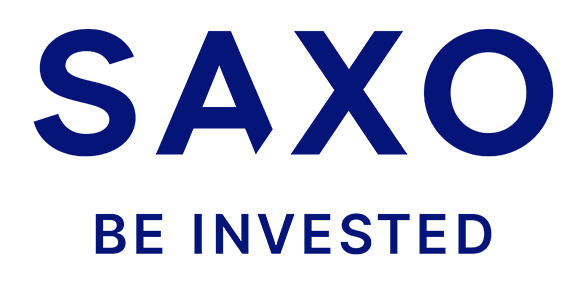 |
 |
| End | Poland | Denmark | Cyprus * |
| Number of exchanges on offer | 16 exchanges | 37 exchanges | 24 exchanges |
| Number of shares in the offer | approx. 3500 - shares circa 2000 - CFDs on shares |
19 - shares 8 - CFDs on shares |
approx. 3 - CFD on shares |
| The amount of ETF on offer | approx. 400 - ETF approx. 170 - CFD on ETF |
3000 - ETF 675 - CFD on ETF |
approx. 100 - CFD on ETF |
| Commission | 0% commission up to EUR 100 turnover / month | according to the price list | Spread depends on the instrument |
| Min. Deposit | PLN 0 (recommended min. PLN 2000 or USD 500, EUR) |
0 PLN / 0 EUR / 0 USD | PLN 500 |
| Platform | xStation | SaxoTrader Pro Saxo Trader Go |
Plus500 platform |
* PLUS500 CY offer
CFDs are complex instruments and come with a high risk of losing money rapidly due to leverage. From 72% to 89% of retail investor accounts record monetary losses as a result of trading CFDs. Think about whether you understand how CFDs work and whether you can afford the high risk of losing your money.
MOEX options
For investors who like to build optional strategies, the Moscow stock exchange offers the possibility of trading options on futures contracts in the "standard" and "mini" versions.
Do you know that…?
Saxo Bank is one of the few Forex brokers that offers vanilla options. The investor has a total of over 1200 options at his disposal (currencies, stocks, indices, interest rates, raw materials). CHECK






















![Forex Club – Tax 9 – Settle tax on a foreign broker [Download the Application] Forex Club - Tax 9](https://forexclub.pl/wp-content/uploads/2024/02/Forex-Club-Podatek-9-184x120.jpg?v=1709046278)
![Trading View platform – solutions tailored to the needs of traders [Review] trading view review](https://forexclub.pl/wp-content/uploads/2024/03/trading-view-recenzja-184x120.jpg?v=1709558918)
![How to connect your FP Markets account to the Trading View platform [Guide] fp markets trading view](https://forexclub.pl/wp-content/uploads/2024/02/fp-markets-trading-view-184x120.jpg?v=1708677291)
![How to invest in ChatGPT and AI? Stocks and ETFs [Guide] how to invest in chatgpt and artificial intelligence](https://forexclub.pl/wp-content/uploads/2023/02/jak-inwestowac-w-chatgpt-i-sztuczna-inteligencje-184x120.jpg?v=1676364263)



![Izabela Górecka – “Success on the market depends not only on knowledge, but also on emotional stability” [Interview] Izabela Górecka - interview](https://forexclub.pl/wp-content/uploads/2024/04/Izabela-Gorecka-wywiad-184x120.jpg?v=1713870578)
![WeWork – the anatomy of the collapse of a company valued at $47 billion [WeWork, part II] wework bankruptcy story](https://forexclub.pl/wp-content/uploads/2024/04/wework-bankructwo-historia-184x120.jpg?v=1711729561)
![Adam Neumann – the man who screwed up Softbank [WeWork, part AND] adam neumann wework](https://forexclub.pl/wp-content/uploads/2024/04/adam-neumann-wework-184x120.jpg?v=1711728724)





![The most common mistakes of a beginner trader - Mr Yogi [VIDEO] Scalping - The most common mistakes of a beginner trader - VIDEO](https://forexclub.pl/wp-content/uploads/2024/03/Scalping-Najczestsze-bledy-poczatkujacego-tradera-VIDEO-184x120.jpg?v=1711601376)
![Learning patience: No position is also a position - Mr Yogi [VIDEO] Scalping - Learning patience - No position is also a position - VIDEO](https://forexclub.pl/wp-content/uploads/2024/03/Scalping-Nauka-cierpliwosci-Brak-pozycji-to-tez-pozycja-VIDEO-184x120.jpg?v=1710999249)
![When to exit a position and how to minimize losses - Mr Yogi [VIDEO] Scalping - When to exit a position and how to minimize losses - VIDEO](https://forexclub.pl/wp-content/uploads/2024/03/Scalping-Kiedy-wyjsc-z-pozycji-i-jak-minimalizowac-straty-VIDEO-184x120.jpg?v=1710336731)



![How to trade the MOEX (Moscow Exchange) index? [Guide] how to invest in moex moscow exchange](https://forexclub.pl/wp-content/uploads/2021/09/jak-inwestowac-w-moex-moscow-exchange.jpg?v=1632473984)
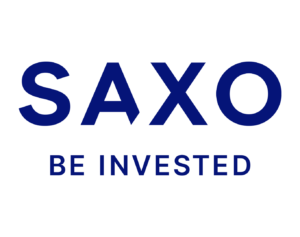

![How to invest in ChatGPT and AI? Stocks and ETFs [Guide] how to invest in chatgpt and artificial intelligence](https://forexclub.pl/wp-content/uploads/2023/02/jak-inwestowac-w-chatgpt-i-sztuczna-inteligencje-300x200.jpg?v=1676364263)

![How to trade the MOEX (Moscow Exchange) index? [Guide] the new bond industry](https://forexclub.pl/wp-content/uploads/2021/09/nowy-bond-branza-kinowa-102x65.jpg?v=1632479554)
![How to trade the MOEX (Moscow Exchange) index? [Guide] china ban cryptocurrencies](https://forexclub.pl/wp-content/uploads/2021/09/chiny-zakazuja-kryptowalut-102x65.jpg?v=1632555878)










Leave a Response